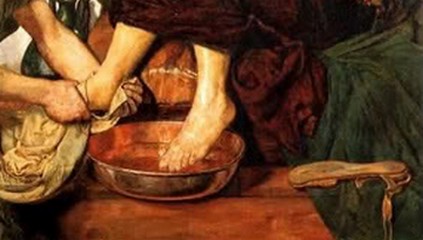
Children catch on the fastest.
Basins come out from behind pews, with stacks of towels and pitchers of warm water. We practice first; showing how to pour the water over toes and ankles and heels, then wrap the foot in a fresh, dry towel. Folks timidly take off their shoes and come forward, apprehensive but drawn in.
It is a wonderful experience to teach the ritual of foot washing to a congregation. And it is most wonderful to see how children lead the way in learning. Free from constraints and worry, they whip off their shoes and don’t care that they have sock fuzz between their toes. They delight in seeing adults do what only children are usually willing to do: become vulnerable. Friends and strangers alike kneel before one another, taking their neighbor’s foot in hand, sometimes laughing out of nervousness. Other times people begin to weep over the great love being shown to their weary bodies.
The rituals of Maundy Thursday — absolution, foot washing, Holy Communion and stripping of the altar — convey honor and worth and love to all human bodies. And while there is opportunity in those actions to experience great tenderness, the real meaning of the gestures is not connected to emotion but obedience.
The church invented Maundy Thursday to draw the people deeper into baptism; it’s promises for life and vocation. Next Thursday is the beginning of the Great Three Days, the culmination of Lent and the entry into Easter. In earlier generations, the church would exile all those who needed to repent of sinning against the community during the weeks of Lent. Maundy Thursday was the day those penitents were welcomed home. The day is formed around reconciliation and forgiveness. In time, the whole church wished to undergo a time of repentance. Lent is now a shared discipline of whole churches. Maundy Thursday acts as a homecoming and reconciliation for all those who have journeyed through Lenten wilderness.
Let us be welcomed and held in God’s embrace like excited, delighted children.






